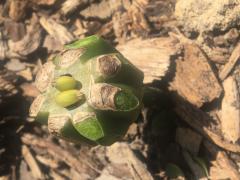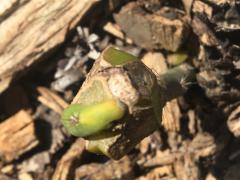-
Posts
1,233 -
Joined
-
Last visited
-
Days Won
44
Content Type
Profiles
Forums
Events
Blogs
Gallery
Store
Everything posted by Inyan
-
Here is another representative of my method of grafting with parafilm. 100% success with the use of parafilm on a 3 day old seedling. This little guy was cut below its cotyledons and only only the top portion was grafted to my Pereskiopsis. The parafilm was removed so you could get a better look, it is best not to remove the parafilm this early however as it can cause your grafts to fail. In fact, it is often best to never remove the parafilm from your graft as your seedlings will have no problem if you leave it in place and could suffer a complete failure to take should you try to remove it too soon.Never leave home without your grafting tape. Also known as parafilm, this one simple tool will save you time, effort, and increase your take rate dramatically with 2-3 day old seedlings as well as 2-3 week old seedlings. For older seedlings...2 cm in diameter.... better to stick with self-adhesive coban.
-

psychaedelics and vegetarianism (pisco-lacto)
Inyan replied to Thelema's topic in Creativity, Spirituality & Philosophy
Pejuta is consumed in the NAC ceremonies. Yet, young puppy is also eaten traditionally in many yuwipi ceremonies. Buffalo stew is often the second go to meat in many of these ceremonies with cow being considered a poor replacement to buffalo. -
Well done grafts. I can see you didn't use parafilm with your grafts which means you likely let your stock dry a bit before and during your grafting procedure which can slow things down just enough to cause a slightly higher fail rate which many try to offset by increasing the humidity. With the use of parafilm, your stock can be watered and fertilized daily. This added water and fertilizer is then pumped into your scion like a bunny on viagra provided you also have warmer summer temperatures. I put my freshly done grafts straight into the green house in the summer if they are particularly important to me.
-
Looks like you like Trichocereus bridgesii a lot! 4 hybrids involving scopulicola, 4 hybrids involving peruvianus, 4 pachanoi....
-
As nice as this graft looks I would not of suspected the stock was any bigger than 1.5 cm tall. Very nice work.
-

Responsibility... How much is enough?
Inyan replied to Inyan's topic in Creativity, Spirituality & Philosophy
I like how you mention it would be rather dole if we were all to agree with something. For me, if we could all agree that rape was inherently wrong, the world might be a better place. Someone who could simply watch a rape occur and not think about it in terms of good or bad is someone that I could not relate. By watching an event unfold such as rape and not wish to doing something to ameliorate the situation to me is a bit unsettling. We may choose to do or not to do, but by witnessing an act we can not say we are innocent and simply an observer as the choice to act or not to act is always present. A person who does not think in terms of good or bad about such a thing as rape for me... is likely to be a sociopath and not capable of real empathy. Empathy for others and the planet... it is as simple as that and intent. Action of course are guided by intent, but also the degree of knowledge we have on a particular subject. For instance, if you know a woman is being raped and beaten into submission and you do nothing that is much different than a women who you might see in the woods who is having what you assume to be consensual sex, but in reality has simply been beaten into submission so many times she no longer fights back. You could simply remain an observer in either case... but what one observes and does nothing to change to me speaks volumes about the person. Are the acts not done just as important as the acts that are done? If the planet is being raped and you do absolutely nothing to change that... is it because you lack power to make a change, knowledge to make a change, or do you simply lack the intent? If you have the power to ameliorate a little bit of the suffering and instead you happily engage in the raping of the Earth or watch as others do the same....What does that say about you? -
The bottom line, if you don't understand science it does not make that science untrue nor does it make those that understand it retards or workers of great magical feats trying to deceive the masses.
-
https://www.giss.nasa.gov/research/briefs/schmidt_01/ For you specifically, since you seem not to understand that bit of science. People that don't understand science to the same degree as those scientists with actual doctorates in their field of study might not be retards as you say, but instead, one might argue they were simply not as well educated on that particular subject. https://www.scienceabc.com/eyeopeners/how-do-we-know-the-temperature-on-earth-millions-of-years-ago.html "Determining one’s ambient temperature with a small amount of effort is ridiculously simple these days. Even a 5-year-old with absolutely no understanding of weather could tell you the current temperature by simply glancing at a smartphone. However, ascertaining temperature was not as easy two centuries ago. In fact, the modern instrumental temperature record could only tell us about the planet’s temperature trends over the last 150 years." "In that case, how do scientists and researchers talk about the climatic conditions thousands or even millions of years ago? How can they tell what the temperatures of Earth were in the ancient past? Short answer: Researchers estimate ancient temperatures using data from climate proxy records, i.e., indirect methods to measure temperature through natural archives, such as coral skeletons, tree rings, glacial ice cores and so on." For more information... please read on. " When we see pictures of dinosaurs basking in tropical heat or wooly mammoths shivering in an ice-covered tundra, how do we know that they lived in such climates? We can tell indirectly from sediments and deposits laid down during these periods. The presence of tropical plant and animal remains at the polar latitudes indicate that significantly warmer conditions must have existed as compared to today. Conversely, the absence of tree pollen in the tundra probably means that conditions were too cold for trees to grow. For more quantitative information you have to look in the oceans, and in particular, at the deep sediments that lie on the bottom of the seas. There, a steady rain of shells from small, surface-dwelling animals falls continually, eventually building up hundreds of meters of sediment. These sediments preserve the shells of these small animals for millions of years, all the way back to the age of the dinosaurs, 65 million years ago. Figure 1: Magnified (400x) photograph of a left coiling N. pachyderma foraminifera. (Photo: Deep Sea Repository at Lamont-Doherty Earth Observatory, Columbia University.) The most important of these animals, foraminifera (or forams for short), make their tiny shells from a form of calcium carbonate (CaCO3). This carbonate is found in many common geological features, such as the White Cliffs of Dover, which were once at the bottom of the sea. What makes calcium carbonate important? The carbonate, originally dissolved in the oceans, contains oxygen, whose atoms exist in two naturally-occurring stable isotopes, 18O and 16O. The ratio of these two isotopes tells us about past temperatures. When the carbonate solidifies to form a shell, the isotopic ratio in the oxygen (written as δ18O) varies slightly depending on the temperature of the surrounding water. The change is only a tiny 0.2 parts per million decrease for each degree of temperature increase. Nevertheless, this is sufficient for us to be able to estimate the temperature of the water in which the forams lived millions of years ago. From this, we can see that temperatures in the Arctic Ocean were about 10-15°C warmer at the time of the dinosaurs than they are today! There is a complication, however. The δ18O value in the shells depends critically on what the δ18O value was in the surrounding sea water (H2O), and that can be as variable as the temperature! This variability arises because when water evaporates, the lighter molecules of water (those with 16O atoms as compared to those with 18O) tend to evaporate first. Therefore, water vapor is more depleted (fewer H218O molecules) than the ocean from which it evaporates. Thus, the ocean has more 18O in places where lots of water evaporates (like the sub-tropics) and less where it rains a lot (like the mid-latitudes). Similarly, when water vapor condenses (to make rain for instance), the heavier molecules (H218O) tend to condense and precipitate first. So, as water vapor makes its way poleward from the tropics, it gradually becomes more and more depleted in the heavier isotope. Consequently snow falling in Canada has much less H218O than rain falling in Florida. Changes in climate that alter the global patterns of evaporation or precipitation can therefore cause changes to the background δ18O ratio. In addition, the great ice-sheets that once covered North America, consisting of snow falling in what is now Canada, were very depleted in 18O. Now, enough water was held in these ice sheets to reduce the global average sea level by about 120m. Furthermore, there was also enough depleted water trapped in the ice to increase the average isotopic content of the oceans. And so the first thing we see when we analyze the shells from the bottom of the ocean, is the waxing and waning of the great ice sheets over the last 3 million years (figure 2). The same pattern over the last 400,000 years can also be seen in the isotopes measured in ice cores drilled from the remaining ice sheets in Greenland and Antarctica. Figure 2: The variations of 18O in carbonate averaged over a large number of different cores (in order to isolate a global signal) over the last 600,000 years. Most clear are the regular oscillations of the glacial ice volume which follows small changes to Earth's orbit around the Sun (Milankovitch forcing). In consequence, the many records of δ18O in ocean sediments and in ice cores, contain information about the temperature, evaporation, rainfall, and indeed the amount of glacial ice — all of which are important to know if we are to understand the changes of climate in the Earth's history. Unfortunately, trying to disentangle these multiple effects is complicated since we have one measurement with many unknowns. The paleoclimate group at GISS is working to try to decode these records using the latest generation of numerical models of the atmosphere and ocean circulation. In those models, we have included most of the physics necessary to simulate the distribution of δ18O in the oceans and the atmosphere. In addition, we have developed models of foram ecology that allow us to estimate at what depths in the ocean and at what season the carbonate forms on average. This sequence of models allows us, for the first time, to map simulated climate changes directly from the model to the carbonate in the sediments — the actual data that paleoceanographers have measured. Initial experiments have focused upon the large climate changes that occurred during the melting of the ice sheets between 20,000 and 10,000 years ago. The closer the modeled changes match those seen in the sediments, the greater the confidence we have in the realism of our models. While this new approach is unlikely to show that mammoths spent their time on the beach enjoying the sun, it may provide better understanding of the complicated sequence of events that marked the end of the ice age. It should shed light on the very rapid climate changes that have occurred in the North Atlantic and Europe at the end of the last ice age. Those particular changes have been associated with changes in the amount of heat carried poleward by the Gulf Stream. If we can understand that process, we may be better able to estimate the probability of its recurrence as a possible consequence of continued global warming. Reference Schmidt, G.A. 1999. Forward modeling and interpretation of carbonate proxy data using oxygen isotope tracers in a global ocean model. Paleoceanography 14, 482-497. Contact Please address all inquiries about this research to Dr. Gavin Schmidt."
-
Just because someone doesn't understand science, doesn't make that science wrong. When 97% or greater of scientists agree on a subject such as global warming there just might be some truth to it. Ever wonder if you were not in fact as intelligent on a particular area of scientific study as the scientists with doctorates in that field? https://www.giss.nasa.gov/research/briefs/schmidt_01/
-

Responsibility... How much is enough?
Inyan replied to Inyan's topic in Creativity, Spirituality & Philosophy
My response, if you see people are not taking responsibilities for their actions and those actions are hurting the environment and others when does it become your responsibility to speak up on behalf of the environment? When do we speak up on behalf of others? When do we band together to affect a greater change for the good? Now, when I listen to a lecture I realize that person must really feel that they have an important message to share. That message may or may not be right, but when the majority of scientists are in agreement on a subject such as mans detrimental influence on our shared environment I tend to take more notice to that type of argument than I might take to an argument such as which person's religious set of rules is right. For me, the message is as simple as understanding ones own personal level of understanding of subject that is indeed very complex in that there are many different scientists studying the effects of mans influence on our environment. If you choose to believe that scientists are lying to you and there is a conspiracy to get you to want to clean up after yourself then I can see that influencing your attitude. If you choose to believe that even a simple act such as taking responsibility for your trash and not tossing it out of your window as your driving is too much to ask then that is your choice based on your own perceptions of what is right or wrong and your own ability to affect the environment around you. I would only ask, that we entertain the idea that we try to become more conscious of how we as individuals affect the environment in positive or negative ways and try our best to create as small a negative effect as possible based on our own limited understanding of a very complex subject. For me, that might simply mean not tossing a bag out my car window. For someone else with a greater understanding of how we affect our environment that might mean that they feel compelled to provide lectures on the subject to others about how we can make changes. Inciting policy changes might be another's goal. I am only suggesting that if you believe we can as individuals affect our environment in a positive or negative way... is it not a good thing to take responsibility for that and try to impact our environment in as positive a manner as we can? I'm not saying we can be perfect or we should strive to be perfect. I'm saying we may choose to strive to be better versions of ourselves, but we have to choose for ourselves how far to push. We have the ability to choose to decide to reflect on these things or not. For me, I choose to believe we are all capable of a small change. Even if all that change amounts to is thinking about how we can make a more positive change, I believe action can eventually follow thought. You don't have to be anxious to love the environment or care for the environment you are a part of. You don't have to be anxious to want to be better in your own personal actions. I enjoy working out. I am trying to improve my own internal environment by doing so. I don't spend countless hours each day doing so. I am not anxious about it. I do realize that even 2 minutes spent exercising each day if done consistently will have a markedly beneficial effect on my own internal environment. I'm not asking myself to be a marathon runner. I'm only asking a very little from myself for myself. If we don't believe that we can do anything for the environment and we are powerless to make any changes in our own behavior then there will indeed be little change. We have to believe there is a possibility for improvement and that we can benefit from that improvement before any action will be taken. But until someone realizes and finds it important then I don't see any real change happening either. I take responsibility for my body by doing a single set of pull-ups for instance. Now, I do that every other day and soon I will find that my pull-ups have gone from 1-10. Now, have I made an improvement in my own internal environment? Was the 20 seconds I spent doing pull-ups every other day worth it? Was it worth an incredible 10 seconds out of my day to do something like that? Taking responsibility for that 10 seconds of averaged time each day may have made me feel better about myself, but was it worth it? Was it worth taking responsibility for my body for 10 seconds to achieve 10 pull-ups? I think we should ask the same when it comes to our interaction with the external environment. You don't have to believe you can be a marathon runner or it is necessary to be a marathon runner. Nor do you have to believe in the science behind global warming. You just have to believe you can have a positive impact on your internal and external environment with a small fraction of your own personal time invested into it and then strive to keep consistent with whatever small change you have decided to take responsibility for. You simply have to be consistent with that small action that you have decided to take and I believe you will have effected a positive change. But in the end, how much responsibility you choose to take and how much action you take will have an affect and whether that affect is one where you have unexpectedly found yourself to be a marathon runner, power lifter, or simply someone who feels better about being able to walk and carry a load of groceries without straining or losing their breath is completely up to you. Small changes over time when done consistently can greatly affect our internal and external world. That is my belief. That is why I choose to take a little responsibility for those things. Is it too much to ask for us all to agree that it is a good thing to take a little responsibility for ourselves and our environment? If we all spent 10-20 seconds each day thinking about how we could have a positive influence on our outside environment would that be too much responsibility to ask for or not enough? Would we still find ourselves locked in debate about even that small amount of time devoted to our own betterment? Or would there still be people who would debate that is entirely unnecessary and a complete waste of time? -
From the album: Trichocereus Freaks
I wanted to get an updated posting of these variegated crested pachanoi as someone has decided they are tired of watching these on their computer and has decided they want them in their own garden.-
- 3
-

-
- crested
- variegated
-
(and 1 more)
Tagged with:
-
From the album: Trichocereus Freaks
I wanted to get an updated posting of these variegated crested pachanoi as someone has decided they are tired of watching these on their computer and has decided they want them in their own garden. -
From the album: Trichocereus Freaks
Variegated seedling -
From the album: Trichocereus Freaks
Another variegated seedling...-
- misplant seedling
- misplant
-
(and 1 more)
Tagged with:
-
I agree that this style of grafting works and can work without pressure or parafilm. However, that style of graft does have a higher success rate when pressure is applied and an increase of humidity is achieved. The fact is you can graft seedlings with a single set of cotyledons vertically or horizontally to one another with ease so long as you can keep the connection between them secure and humidity is kept high enough to ensure the seedlings do not dry out too fast. Whether you are grafting a single areole or a seedling that has just sprouted its first hypocotyl... the basics are much the same. One need only listen to what your cacti are trying to tell you and you will soon succeed. Excellent work my friend.
-
From the album: Trichocereus Freaks
Crest -
From the album: Trichocereus Freaks
Crest -
From the album: Trichocereus scopulicola x Trichocereus terscheckii
scopulicola x terscheckii as of 21 June 2018 -
From the album: Trichocereus scopulicola x Trichocereus terscheckii
scopulicola x terscheckii as of 21 June 2018 -
I mix bone meal, blood meal, cow manure, and fish emulsion into my soil for Pereskiopsis and as I drink 6-12 eggs a day... those egg shells also find their way into my soil for my Pereskiopsis. If your looking for hard numbers, I'm not your guy. I'm the type that simply mixes things up until the soil looks right and feels right. Pereskiopsis are like Brugmansia though in that if you grow them together and your Brugmansia is very happy... then your Pereskiopsis will also be happy. Both are heavy feeders. With that being said, I've also simply stuck Pereskiopsis in the ground outside after it was tilled as Pereskiopsis also loves room to grow its roots. A root bound Pereskiopsis in a small container can work wonders for small grafts, but if you want faster growth over a longer period of time.... upsize the container your stock is in prior to grafting. Any loose clippings of Pereskiopsis can also be simply tossed on a well tilled ground and they will set roots for you and start growing on their own. I know this is kind of basic, but I figured a little information was better than none.
-
Well that makes more sense now that at least the pad was not shriveled at the start. While it is possible to graft cacti to stock that is not rooted, I find that my luck with that is better on stock that was actively growing at the time of the cut and then grafted within a week of cutting. I like your idea of rot proof taproots as well. This stock will definitely give you that as well as your more natural looking growth. As for your enthusiasm, I can't say I might not have tried this myself if I had a surplus of both stock and scion material. My own problem is generally not enough stock and too many seedlings, but that can change with the drop of a hat depending on the season. Your definitely one of the smart cats which is why I posed those questions to you my friend. For me, I have to ask why something doesn't work and what can I do to fix it this time and if not this time then I've learned something for next time. My best piece of advice on the graft you have shown the picture of... water it heavily next time. Opuntia humifusa can take wet feet.
-
I only move to the shade if the stock or scion was in the shade to begin with or I'm not using something to boost the humidity like parafilm. However, if you use a growth chamber to increase humidity, you have to be aware that chambers will also increase the heat which can be a bad thing if they are placed in direct sun too long during the heat of the day. You might try intermittently bring your grafts out if you are using a humidity chamber with good effect if done for just a few hours off and on throughout the day. As regards your first graft, it looks like you need to go ahead and slice the sides off of that graft. Use a brand new razor blade for this as this will enable your graft to breath. It looks like it has taken and all is good. Dust with sulfur. Alternately, if your not sure of your steady hands... suck up a bit of sulfur dust in a syringe. Poke a few needle holes gradually over the outer edge of one side of your graft and and then the other side do the same. Slowly introduce a bit of that sulfur as a dust onto the surface of your graft. Great job with the parafilm by the way!
-
Opuntia humifusa can take freezing temperatures and floods both without skipping a beat. For grafting purposes, I personally prefer to graft on nice plump vigorously growing specimens. My theory being that if my stock is dehydrated and in need of water itself... how much fluid is it going to be pumping into my graft? You band kept your specimen from floating off for 9 days... provided it had an abundance of fluid that the stock could push into your graft that would help. Why use a pad that is not swollen to the hilt? The more swollen a stock is the more it can push its nutrients into the scion. Why use an unrooted stock to graft? Without roots, a stock will have to use its own reserve energy and fluids to grow new tissues to support a union between the stock and scion. Why was the graft moved to a lower light area? Light stimulates growth. As for your question as to humidity in relation to your Opuntia rooting.... Humidity is not essential for rooting your Opuntia. Rooting your Opuntia can be best expedited by increasing bottom heat and soaking your Opuntia humifusa in water and nutrients. Personally, I would grow that Opuntia in a bog style environment with a heaping dose of fertilizer added to the water. I'd go with a nice aqua blue, green, or muck brown color to the water to ensure a good amount of fertilizer was added. Humidity is more important however in a graft of this type to keep the graft union hydrated so living tissue can form before that same tissue dries out. Even a small imperfection such as a double cut when you are slicing your stock or scion can create a space for an air bubble which is hopefully mitigated by the pressure of the rubber band and the increased humidity in your growth chamber... or one could simply wrap with co-ban or another material to hold more moisture in at the graft site itself. Nice collection by the way. I assume you went with Opuntia humifusa as you wanted a slower growing stock or a stock that would not rot if overexposed to water? Either way, it was a good choice.
-
Some Datura pictures...Datura wrightiiDatura discolorDatura metel var. fastuosaDatura quercifoliaDatura stramonium


















